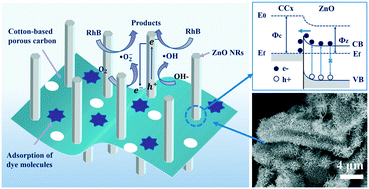N-Doped cotton-based porous carbon/ZnO NR arrays: highly efficient hybrid photo-catalysts†
Abstract
The protection of water resources has attracted enormous consideration aswater pollution is now the bottleneck of sustainable development of popular society. For this purpose, eco-friendly efficient photo-catalysts are urgently required. This work focuses on the synthesis and characterization of nitrogen-doped porous carbon/ZnO nanorod arrays (PC/ZnO NRs) as a photo-degradation catalyst. Using absorbent cotton as a carbon source, nitrogen doped porous carbon was obtained by urea decomposition during the carbonization process of cotton at set temperatures. ZnO NRs were grown on the porous carbon to form the PC/ZnO NR hybrid. The prepared samples were systematically characterized, and their photo-catalysis capability was evaluated by the degradation process of rhodamine B (RhB). It is found that PC500/ZnO NRs demonstrated an efficient photo-catalysis under Xe lamp irradiation, such that over 96.5% of RhB (10 ppm) could be photo-degraded within 20 min with 10 mg. The mechanism is discussed based on the tight interfacial bonding and the appropriate Fermi energy between porous carbon and ZnO NRs, which enhanced the separation efficiency of photo-generated charge carriers and provided an ultrahigh density of catalytic reaction centers. Overall, this green and scalable fabrication technology will provide new insights into a reasonable design for high performance photo-catalysts and environmental pollutant management.



 Please wait while we load your content...
Please wait while we load your content...